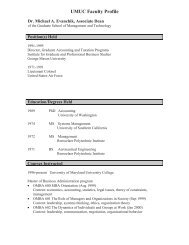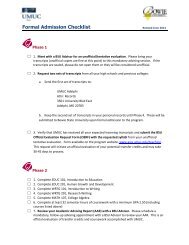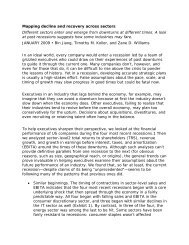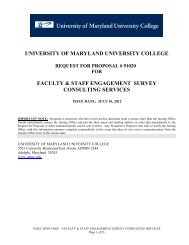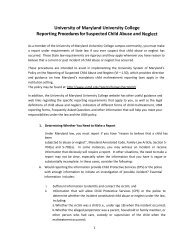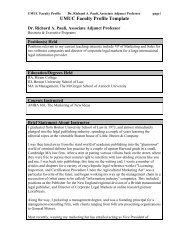1a. IntroSUS 2003 - University of Maryland University College
1a. IntroSUS 2003 - University of Maryland University College
1a. IntroSUS 2003 - University of Maryland University College
- No tags were found...
You also want an ePaper? Increase the reach of your titles
YUMPU automatically turns print PDFs into web optimized ePapers that Google loves.
BMGT 327 Financial Analysis and Planningfor Entrepreneurs (1)A foundation in the principles <strong>of</strong> ratio analysis for owners (orwould-be owners) <strong>of</strong> small businesses. Focus is on reading and interpretingfinancial statements. Methods <strong>of</strong> developing and integratingplans for enhancing pr<strong>of</strong>itability and performance are presented andexplained. Students may receive credit for only one <strong>of</strong> the followingcourses: BMGT 327, BMGT 398D, MGMT 327, MGMT 398J,or SBUS 398A.BMGT 330 Entrepreneurship and NewVenture Planning (3)Recommended: Familiarity with computers and business s<strong>of</strong>tware.An overview <strong>of</strong> entrepreneurship and planning new business venturesfor prospective entrepreneurs and managers. Topics includedeveloping entrepreneurial ideas and innovations; strategic planning;marketing research, analysis, and planning; advertising, promotion,and sales; financial planning and financing; operations and servicesplanning; human resources planning and management; analysis <strong>of</strong>risk; information management strategy and the Internet; legalaspects <strong>of</strong> new venture formation; and global venturing. Entrepreneurialtheory, pr<strong>of</strong>iles and roles <strong>of</strong> entrepreneurs, business lifecycles, entrepreneurial behavior, use <strong>of</strong> computer s<strong>of</strong>tware to aid inplanning, and entrepreneurial management and technology issuesare explored. Discussion and group activities focus on development<strong>of</strong> a business plan, the factors that should be considered, and theentrepreneur’s role in developing and operating a new business.Students may receive credit for only one <strong>of</strong> the following courses:BMGT 330, MGMT 330, or SBUS 200.BMGT 334 Managing New Ventures (3)Prerequisite: Familiarity with new venture planning; BMGT 330recommended. An exploration <strong>of</strong> the start-up and development <strong>of</strong>business ventures using an integrated approach to entrepreneurship,growth, and management. Topics include opportunities at differentstages, legal structure, production <strong>of</strong> goods and services, marketingstrategies, access to capital and capital formation, policy formation,and development <strong>of</strong> a management philosophy. How entrepreneursmake decisions—on growth <strong>of</strong> the venture, organizational structure,hiring <strong>of</strong> key employees, information systems, s<strong>of</strong>tware and hardwareuse, and building <strong>of</strong> corporate culture is also examined. Problemsand pitfalls to avoid, implementation and periodic review <strong>of</strong>the business plan, global issues, cultural diversity, and the use <strong>of</strong> newtechnologies are considered. Students may receive credit for only one<strong>of</strong> the following courses: BMGT 334 or MGMT 334.BMGT 336 Managing Strategic VentureGrowth and Industry (3)Prerequisite: Familiarity with the business functions and factorsinvolved with planning and managing a new venture; BMGT 330recommended. A study <strong>of</strong> business ventures during the growth andmaturity phases <strong>of</strong> development using an integrated approach toentrepreneurial management. Growth problems, major issues, andmanagement strategies for businesses in the later stages <strong>of</strong> developmentare explored. Topics include budgeting and planning for continuedgrowth; developing new products, features, and productenhancements; and identifying new sources <strong>of</strong> capital and expandinginto other domestic and global markets. Consideration is givento how to implement cost controls, reorganize to rekindle entrepreneurialintensity, encourage innovation, and make staffing changesto achieve growth. Cultural diversity and the use <strong>of</strong> new technologiesare also examined. Students may receive credit for only one <strong>of</strong>the following courses: BMGT 336 or MGMT 336.BMGT 337 Building the EntrepreneurialTeam (3)Prerequisite: Familiarity with business functions and factors involvedwith planning, organizing, and managing a new venture; BMGT330, BMGT 334, or BMGT 336 recommended. An exploration <strong>of</strong>growing ventures that focuses on the development <strong>of</strong> the businessand key personnel and includes entrepreneurial human resource andsupport issues, ethics, and accountability. The appropriateness <strong>of</strong> theform <strong>of</strong> the venture—partnership, joint venture, strategic alliance, orlicense—is examined. Topics include ways <strong>of</strong> controlling and minimizingconflicts in the team; recruiting, motivating, and retainingteam members; ensuring the responsibility and accountability <strong>of</strong>team members; and managing the team. Functional responsibilitiesand relationships are also discussed. Analysis covers issues related tothe organization’s structure, protection <strong>of</strong> proprietary information,intellectual property assignment, location and performance <strong>of</strong> work,the evolving responsibility <strong>of</strong> the entrepreneur, negotiation withemployees, and the multicultural employee base. Students mayreceive credit for only one <strong>of</strong> the following courses: BMGT 337 orMGMT 337.126





